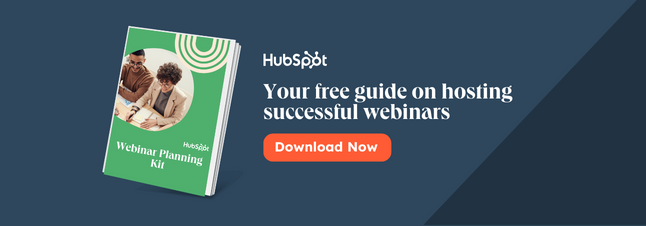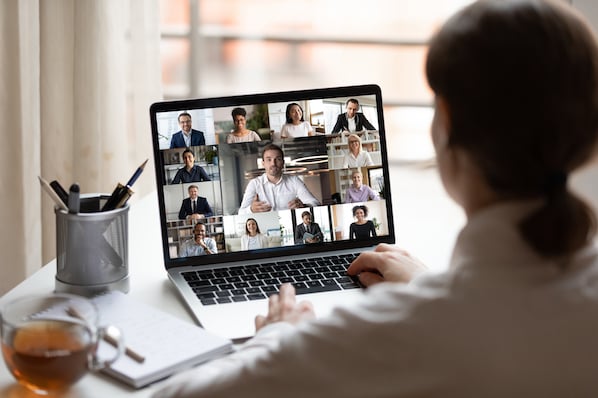In 2020, with conferences and events going virtual, a number of brands around the world have heavily embraced webinars.

Along with allowing marketers to educate audiences about topics related to their brand, webinars can also offer major lead generation benefits.
But, while a number of successful marketing pros make creating webinars look easy, there's actually a hefty amount of work that needs to go into planning them in order to see solid engagement.
The lead-up to a webinar requires other facets of inbound to come into play -- everything from getting a speaker to join the webinar, to planning blog and social posts to promote it, to developing the actual topics and focus for the event.
At this point, you might be asking yourself if there's a checklist that can assist you in your webinar planning.
Well, look no further. Below, I've outlined 12 tactics you should focus on to ensure you and your team are fully prepared to put on a high-quality, successful webinar.
How to Prepare for an Engaging Webinar
1. Interact with your audience through promotions before the webinar.
If your audience doesn't know about your webinar or isn't excited about the topic, they won't sign up.
Be sure to tweet about the event, write blog posts promoting it, and come up with other creative ways to share it online. To engage attendees -- even before your event, your promotional messages, such as social posts or emails, can ask for people to submit their questions or comments beforehand.
Also, if you have some type of webinar giveaway or special feature during the webinar, circulate that information to further differentiate your webinar from similar events held by competitors.
For example, we once gave out tickets to INBOUND, our inbound marketing conference, to a person who tweeted our webinar's hashtag before, during, and after the webinar. This helped us get audiences to participate in promotions on top of our other marketing efforts.
For more on promoting webinars and other virtual events, check out these tips from HubSpot experts.
2. Create an eye-popping slide deck.
To keep an audience engaged for 30 minutes to an hour, you'll need to give them something nice to look at. So, make your slide deck is visually appealing.
Create image-heavy slides that relate to the topic you are discussing. Using copy on slides is fine -- if done correctly. Don't simply write a paragraph on a slide in black and white. Instead, make sure the copy adds to the presentation. Stick to one color palette throughout the webinar deck, and try not to make it too busy.
Take a look here to see what a blase, paragraph-only slide looks like (on the left) and what one with color and images (in other words, one that's got some life to it) looks like (on the right):

3. Dedicate a hashtag to your webinar.
As mentioned in the first section, you can consider using a hashtag through the webinar marketing process that is unique to your virtual event. Using a lesser-known hashtag or creating a brand new one will help ensure all tweets with the hashtag are about your webinar.
For example, we used #TwitterQA for a past webinar that featured a Q&A with an Twitter executive. In scenarios like this, we use a webinar hashtag well before the webinar to create a community of people with something in common. During the webinar, we use the hashtag to interact with the audience, answer technical questions, and gather questions for the Q&A portion.
Finally, after the webinar, we use the hashtag to follow up on any unanswered questions and send additional information.
4. Seek one or more thought leaders or experts to present.
Nothing is worse on a webinar than a monotone speaker who puts the audience half asleep. Pick a webinar host who is personable, energetic, and an expert in the topic you plan on discussing.
Additionally, if you have more than one speaker, have them play off of each other, making the webinar a discussion instead of two different monologues.
If you are able to access experts in your industry, or thought leaders with higher followings on platforms like LinkedIn, you should also consider including them in your webinar.
Leveraging experts will make your event more interesting for your audience and could also pull in listeners that have followed that experts work. You can additionally leverage these people for online co-marketing tactics before, during, and after the event.
5. Meet with all the speakers beforehand.
For an extra smooth webinar, consider hosting a quick meeting that will allow you and other webinar panelists to walk through the webinar topic and get to know eachother.
Juliana Nicholson, a HubSpot Program Manager who's been involved with a number of webinars including our Adapt series, strongly encourages a get together like this before you launch the event.
"Don't have the first time your host and panelists meet be the day of your webinar," says Juliana Nicholson, a HubSpot Program Manager. "Set up some time ahead of the event for the host and speakers to get to know each other, and run through day-of details."
Nicholson, who most recently planned webinar content for our Adapt 2020 series, explains, "Everything from pronouncing people's names to knowing who to call of first for each question will feel a lot more smooth day of, if you practice beforehand."
6. Leverage speaker and company social media handles in your promotions.
While the webinar is being run by you and your organization, you'll still want to allow your audience to interact with the speaker(s) as well, so be sure to make their Twitter handle(s) known, both in your promotions, as well as throughout the webinar presentation.
Not only does it give a personal touch to your webinars, but also think of all the new followers you could get!
7. Have at least one host or moderator.
Getting one or more speakers to join your webinar can really liven the conversation, but that convo can lose track pretty quickly if no one is assigned to moderate the discussion.
Simply put, a webinar host can help with the flow of the presentation. This person introduces the speakers, asks any questions that come up during the webinar or Q&A, and concludes the event. If any problems arise, this person can address them easily, without causing the speakers to get off-topic.
8. Leverage different types of media in your webinar.
To keep audiences engaged during the event, you should consider using a variety of media types for your webinar.
Do you have a short video or animation that will help your demonstrate your point? Does sharing your screen temporarily help get a point across? Would a downloadable checklist help your audience follow along with your discussion? Think about how you can complement your webinar with other forms of media, either during or after the webinar.
Recently, we hosted a webinar with Guy Kawasaki that was 100% screen-sharing. Guy walked us through his daily social media activities, down to how he takes screenshots and posts them on Twitter! Talk about a highly interactive webinar.
9. Consider other audience engagement strategies.
With webinar platforms expanding their features daily, there are now many more ways to engage your audiences than there were in the past. For example, many platforms let audiences comment with questions, vote in polls, or take quizzes during the webinar.
As a moderator or webinar planner, get creative and consider ways to leverage these elements so your audience doesn't feel like they're passively listening to speakers rather than engaging with them.
"Don't let audience engagement be an afterthought. Know how and when you want to engage the audience," Nicholson advises. "Will you have formal Q+A? How will people submit questions? When will you answer those questions? All this should be pre-determined and clearly communicated to set your attendees up for a good experience."
10. Perform thorough audio and video checks.
Even in today's world, technical problems happen with software. Do your best to avoid them when on the air live by testing your webinar platform ahead of time.
For example, you might not realize it, but your computer's sound could be muffled, or your headphones could prevent people from hearing sounds played on your screen. This is why you'll want to do at least one sound check before you present.
Similarly, you'll also want to make sure you pick a workspace with good lighting.
Additionally, you should also troubleshoot for more unexpected technical slip ups. For example, if you're going to be sharing your screen or switching controls, have a pre-webinar dry run where speakers can practice before doing it live.
Ultimately, it's always best to find out where mistakes could occur before the actual webinar so you don't waste your time or that of your guest speaker(s).
11. Take time zones into consideration when scheduling your event.
When choosing a time to host your live event, keep in mind that not everyone will be in your time zone. HubSpot is located in Eastern Standard Time, so we try to host webinars at a time that works for other areas around the country and across the globe.
For example, though 1 p.m. to 3 p.m. EST often works for us, it may not suit our European audience well, so we'll need to find a time that works for both of us.
Nicholson also suggests that marketers should "make it clear if your webinar will be recorded and that by signing up someone will get that recording. You'll increase conversions even when someone cant attend live."
12. Host your webinar in a quiet, non-distracting workspace.
Don't underestimate the importance of the physical location of your webinar. I sit next to a sales team who are on the phone all day. If I tried to host a webinar from my desk, the audience would hardly be able to hear me! Thus, I make sure to find a quiet (sound proof is even better) room elsewhere in the office.
If you have multiple people speaking in the same room, make sure to have a high-quality speakerphone. To avoid any technical problems, I avoid using the wireless internet when at all possible and test everything beforehand.
Planning the Perfect Webinar
Yes, it takes lots of time to plan a webinar, but the benefits might just be worth it. As you plan, keep in mind that most of the tips on this list aim to boost audience engagement.
While an informative webinar is a great start, sharing a basic lecture with your attendees might not cut it. Your audience will listen more actively, enjoy the content more, and continue signing up for webinars if they feel engaged throughout the event.
For more webinar tips, check out this ultimate guide. If you already think you're planning great webinars, but don't know where to start with promoting them, check out this post with tips from HubSpot marketing experts.











![How to Write a Webinar Script [+ Template]](https://www.hubspot.com/hubfs/181_Write-a-Webinar-Script.png)